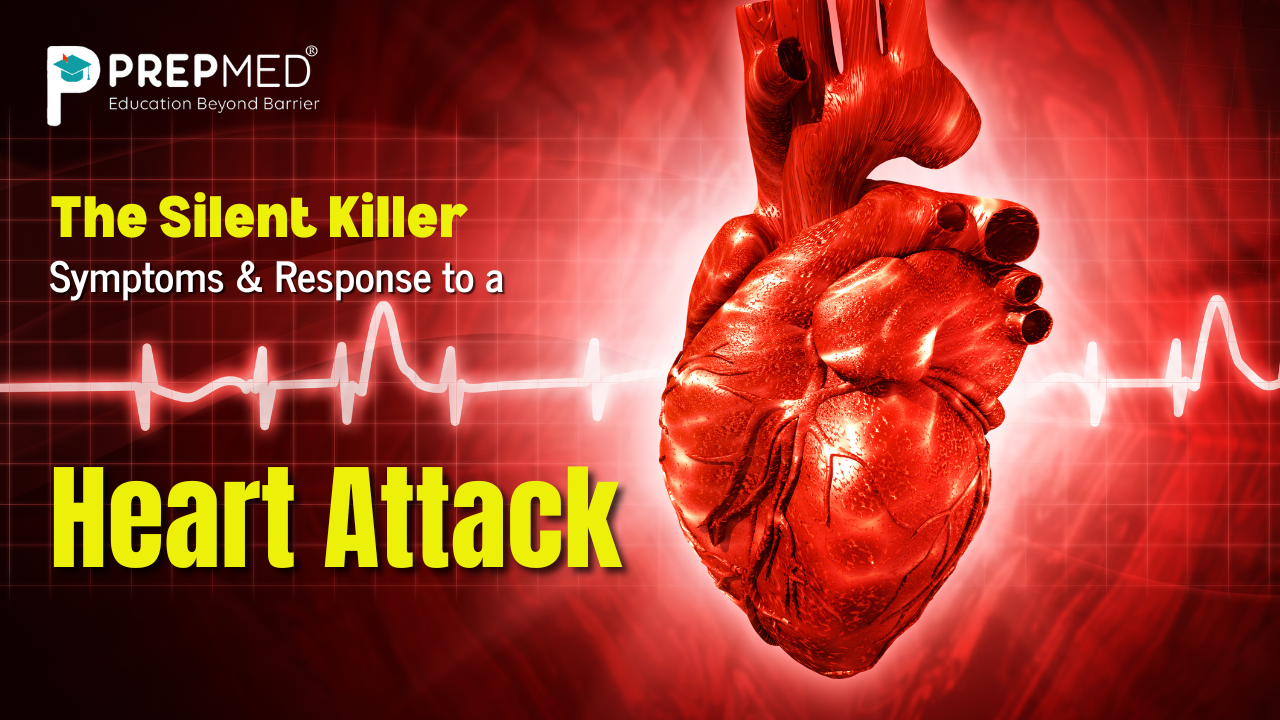February 01, 2025
The Silent Killer: Symptoms & Response to a Heart Attack
Heart attacks are known as the "silent killer" because their initial symptoms easily escape detection or misinterpretation thus extending treatment delays. The early recognition of warning indicators plays a crucial role in saving lives. Heart attacks manifest through common symptoms including chest pain or discomfort and shortness of breath or lightheadedness and nausea but these symptoms show varying patterns between women and people with existing medical issues.
The pain associated with a heart attack rarely remains confined within the chest because it often extends to various areas of the body including jaw, back, shoulders, arms, and abdomen. The risk of heart attack surges with high blood pressure and high cholesterol, smoking, diabetes and presence of hereditary heart diseases.
- The practice of living a healthy active lifestyle along with proper dietary habits combined with successful stress management decreases the risk of a heart attack.
- Chewing aspirin may help reduce heart damage if done quickly, but only if advised by a medical professional.
- Early intervention, such as administering CPR or using an automated external defibrillator (AED), can also improve survival rates until help arrives.
Always remember, early recognition of heart attack symptoms along with fast response actions determines your chance of heart attack survival.
What is a Heart Attack and Why It's Called the Silent Killer?
A myocardial infarction known as heart attack, stops blood flow to heart muscle tissue due to a blood clot usually blocking arteries. The resulting heart tissue damage or death occurs because the blockage cuts off essential oxygen and nutrients delivery to the heart muscle. Heart attacks can happen suddenly, but often there are warning signs that go unrecognized, which is why it's sometimes referred to as the "silent killer."
Heart attack is named as "silent killer" because many heart attacks don’t cause obvious symptoms in the patients and are mistaken for less serious conditions like indigestion or muscle pain. As a result of which, the actual treatment for a heart attack gets delayed. In some cases, a person may experience mild chest discomfort, shortness of breath, or fatigue, but not realize the severity of the situation. People often dismiss these symptoms as regular stress responses or normal signs of aging or other common factors which delays proper medical diagnosis.
Heart muscle damage becomes irreversible when treatment is not received instantly. Fast recognition of any heart attack symptoms regardless of their intensity will enhance the chances for survival while minimizing long-lasting heart damage.
Common Symptoms of a Heart Attack: What to Look For
It is very crucial to recognize the symptoms of a heart attack is crucial for early treatment. The most common sign is chest pain, however the symptoms of a heart attack can vary widely among different individuals.
- The most common symptom is chest discomfort or pain, often described as a feeling of pressure, tightness, or heaviness in the chest. This pain may last for several minutes or come and go. It’s typically located in the center of the chest but can radiate to the arms, back, neck, jaw, or stomach.
- Another common symptom is shortness of breath, which may occur with or without chest pain. It can be sudden or gradual, making it difficult to catch your breath even with minimal exertion.
- In some cases, individuals may experience nausea, light-headedness, or even fainting, especially if the heart attack is severe.
- Women, older adults, and people with diabetes might not always have the typical chest pain. Instead, they may experience more subtle symptoms such as fatigue, discomfort in the upper back, or dizziness.
Being aware of these symptoms and acting quickly can save lives.
How Heart Attacks Differ in Men and Women
The heart attack symptoms in men are generally intense chest pain or pressure, often radiating to the left arm, jaw, or neck. Men are also more likely to experience heart attacks at a younger age, due to various lifestyle factors like smoking, high cholesterol, or obesity.
Women, on the other hand, may experience symptoms like nausea, lightheadedness, shortness of breath, fatigue, or discomfort in the back or stomach. These symptoms can easily be confused with indigestion or stress, leading to delays in seeking medical help. Women are also more likely to have a heart attack later in life, often after menopause, and may face a higher risk due to factors like hormonal changes, high blood pressure, or diabetes.
Immediate Steps to Take When You Suspect a Heart Attack
A person needs to take fast action in situations where they suspect a heart attack. Take the following steps right away.
- Contact emergency services by dialing 911 before starting any additional actions. Fast emergency response leads to enhanced survival possibilities and faster recovery for a person suffering from a heart attack.
- Offer the person a 325 mg chewable aspirin tablet if aspirin is available, only if they have no aspirin allergies. The blood-thinning effect of aspirin may lead to reduced damage to the heart during a heart attack.
- Encourage the affected individual to sit down and maintain calmness while resting. Physical activity should be avoided since it adds more strain to the heart.
- Constant observation of the victim's breathing and pulse rates is essential. Start CPR immediately if you know how to perform it on the individual who loses consciousness and stops breathing.
- If someone has received doctor-prescribed Nitroglycerin, help them follow their prescription instructions carefully. The patient should never receive medications that belong to others.
- Never offer the patient any food items or liquids. Emergency surgery becomes safer for patients when they avoid eating and drinking before medical intervention.
- Be present with the person while offering reassurance and comfort until professional support arrives. Being physically present creates a sense of reassurance through your supportive behavior which minimizes their anxiety levels.
Preventing Heart Attacks: Healthy Habits for a Stronger Heart
Try to adopt healthy habits that will not only protect the heart but also improve your overall well-being. By making mindful choices about your health, you can reduce your risk and promote a stronger heart for years to come.
1. Focus on eating a heart-friendly diet: Indulge on a diet rich in fruits, vegetables, whole grains, skinny proteins, and healthy fats( like those found in olive oil, nuts, and fish). Try to limit saturated and trans fats, and sodium, as they can raise cholesterol and blood pressure, contributing to heart complications.
2. Maintain a regular exercise routine: Regular physical exercise strengthens the quality of your heart and improves blood circulation throughout your body. Aim for at least 30 minutes of moderate exercise, like brisk walking. Exercise also helps to maintain a healthy weight and reduces unnecessary stress.
3. Reduce Stress levels: Unnecessary stress can take a massive toll on your heart. Find healthy ways to manage stress, like meditation, deep breathing, or hobbies, that can help lower the danger of heart problems.
4. Avoid smoking: Smoking is a major danger factor for heart complications, as it damages blood vessels and lowers oxygen levels in the blood. Quitting smoking can significantly reduce your risk of heart attack.
5. Check your Blood Pressure and Cholesterol on a regular basis: Regularly check your blood pressure and cholesterol levels. Consult with your doctor and ask for ways to manage them through lifestyle changes or medicine, if they're elevated.
6. Maintaining a balanced weight: Being fat or overweight increases the danger of heart disorder. Achieving and maintaining a healthy weight through diet and exercise is critical for managing the overall health of your heart.
7. Limit Alcohol Consumption: Excessive alcohol can raise blood pressure and contribute to heart problems. Refrain from consuming alcohol.







